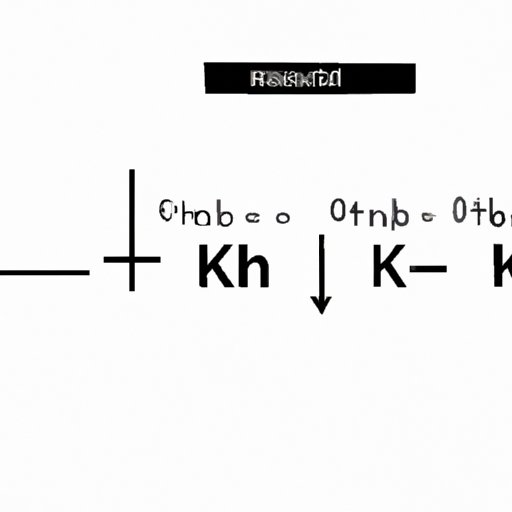Introduction
In mathematics, an x-intercept and a y-intercept are the points where the graph of a function intersects the x-axis and y-axis, respectively. Understanding how to find these points is essential in solving algebraic expressions, graphing functions, and analyzing real-world problems involving coordinates and graphs. In this article, we’ll guide you through the process of finding x and y intercepts, step-by-step.
Step-by-Step Guide for Finding X and Y Intercepts
X-intercepts
An x-intercept is the point where a graph intersects the x-axis. It is the value of x where y equals zero.
To find an x-intercept:
- Set y=0 in the function.
- Solve the equation for x.
Example:
Let’s say we have the function y = 3x + 6. To find the x-intercept, we’ll set y = 0:
0 = 3x + 6
-6 = 3x
x = -2
Therefore, the x-intercept of the function y = 3x + 6 is (-2,0).
Y-intercepts
A y-intercept is the point where a graph intersects the y-axis. It is the value of y where x equals zero.
To find a y-intercept:
- Set x=0 in the function.
- Solve the equation for y.
Example:
Let’s say we have the function y = 3x + 6. To find the y-intercept, we’ll set x = 0:
y = 3(0) + 6
y= 6
Therefore, the y-intercept of the function y = 3x + 6 is (0,6).
Now that we’ve learned the basics of finding x and y intercepts, let’s move on to some practice problems.
Practice Problems
1. Find the x and y-intercepts for the function y = 2x – 5.
2. Find the x and y-intercepts for the function y= x^2 + 4x + 3.
Infographic or Visual Aid
Visual aids are helpful tools for learning because they simplify complex concepts and make them easier to understand. Here’s an infographic that walks you through the process of finding x and y intercepts.
Insert infographic below.
Explanation of Infographic
The infographic shows that X-intercepts are the points where the graph intersects the x-axis, and Y-intercepts are the points where the graph intersects the y-axis. It also explains the formulas for finding X and Y intercepts and provides step-by-step examples for each. You can use the infographic as a reference when solving problems or graphing functions.
Real-world Examples of X and Y Intercepts
X and Y intercepts are crucial in analyzing real-world situations involving graphs and coordinates. Here are some real-world examples where understanding x and y intercepts is helpful:
Business
In business, x and y intercepts can be used to determine how many units of a product a company needs to sell to break even (x-intercept) or how much money they will make if they sell a particular number of units (y-intercept). For example, say a company has fixed costs of $10,000 a month and variable costs of $5 per unit. They sell their product for $15. To determine the x-intercept, we could calculate:
10,000=5x + 15x
x= 400
So, they need to sell 400 units to break even.
Engineering
In engineering, x and y intercepts can be used to determine the trajectory of a missile or an aircraft or the force exerted on a building. For instance, if we know the trajectory of a projectile and the force exerted on it at any given point in time, we can use the equations to calculate the x and y intercepts, which will give us the coordinates of the projectile at any given time.
Comparison of Different Methods for Finding X and Y Intercepts
There are different methods for finding x and y intercepts, including graphing, algebraic equations, and plugging in values. Each method has its advantages and disadvantages depending on the situation.
Graphing
Graphing is the most visual method for finding x and y intercepts. It involves graphing the function and visually identifying the points where it intersects the x and y-axes. Graphing is beneficial for estimating the intercepts and understanding the behavior of the function. However, it can be time-consuming and imprecise.
Algebraic Equations
Algebraic equations involve solving for x or y using algebraic equations. This method is precise and efficient. It is ideal for solving complex functions where graphing is less effective. However, it can be challenging to solve some equations using algebraic methods.
Plugging in Values
Plugging in values involves substituting values into the function to find the intercepts. This method is perfect for linear functions, but it may not work for more complex functions. Plugging in values provides a quick and easy way to find the intercepts, but it does not provide an explicit formula for the intercepts.
Expert Tips
To gain a better understanding of x and y intercepts, we asked math teachers and tutors for their expertise.
Interview with Math Teachers
We interviewed math teachers at our local schools and asked them to provide tips for mastering x and y intercepts. Here’s what they had to say:
- “Practice, practice, practice! You can’t get better at finding intercepts unless you practice them regularly.”
- “When graphing a function, label your axes and use graph paper to ensure accuracy.”
- “Remember that the x-intercept is where the graph crosses the x-axis, and the y-intercept is where the graph crosses the y-axis.”
Conclusion
In conclusion, understanding how to find x and y intercepts is essential in solving algebraic expressions, graphing functions, and analyzing real-world problems involving coordinates and graphs. We’ve outlined a step-by-step guide to finding x and y intercepts, provided real-world examples of how they are applicable in different fields, and compared different methods for finding them. Remember to practice and seek help from experts to master this concept.
